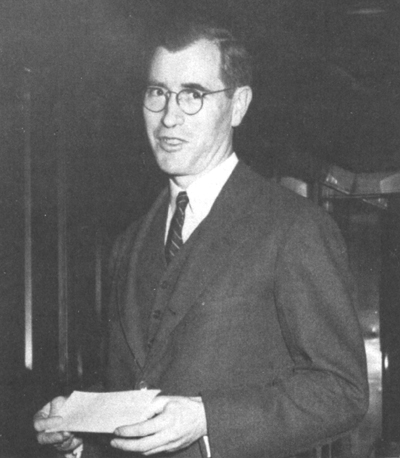IBM's John McPherson, 1908-1999
Written by

He helped with the older machines, and with the 603 and the 604 as electronics burst out. I was in his office the day he laid out the CPC for Northrop. He sent Pete Luhn and his one-off relay computers to the Watson Lab, and encouraged John Lentz to do the 1620 prototype there, and By Havens to design and build the first supercomputer [NORC] around the corner on Broadway and on 115th Street.
He was the door through which almost all the IBM inventors and engineers, and us scientific types, reached TJ (Bryce and Eckert had direct access). I call him a monitor; he didn't give orders, but he passed requests from la bas to Watson, and Watson's orders to nous ouvriers. He was unquestionably the central figure in the IBM technical escalade from 1930 to the early Fifties. Eckert had the scientific vision, Hurd had the marketing vision, but John put it all together and channeled the overwhelming power of The Old Man to the whole computing community.
My own relationship with him was unsymmetrical. From my first contact for over four decades I admired him, although I suffered occasionally from his stiffness; he thought me unruly – a tummeler, as they say in the Catskills. His access to Watson, and the trust The Old Man put in him, turned Young Tom hateful, and destroyed his later years. I'm happy that Emerson Pugh does so well by him in Building IBM. I'm very unhappy that he never made the NAE, just as Eckert never made the NAS, and regard it as a proof that those academies are far from impeccable. Palmer and Haddad and that ilk owed much of their recognition to John, as Brouwer and Clemence and Herget owed much to Wallace. I'm glad, proud, to have known him.
- John C. McPherson (not to be confused with several other John McPhersons, including at least two at IBM) received an EE degree from Princeton University in 1929 and joined IBM in 1930. He was IBM's Director of Engineering 1943-46, became an IBM VP in 1948, and was first director of IBM's graduate-level Systems Research Institute 1960-65. He retired in 1971.
- "The Old Man" = TJ = Thomas J. Watson "Senior".
- "Third most powerful computing center in the world" (after Harvard and the US Army Ballistic Research Laboratory at Aberdeen, MD).
- Clair D. Lake (1888-19??), IBM inventor and engineer from 1915 through the 1950s.
- Stephen (Red) Dunwell (1913-1994) would go on to head IBM's STRETCH project.
- Benjamin M. Durfee (1897-1980), Don Piatt: IBM engineers who worked on the Aberdeens and the SSEC.
- MAGIC... Breaking Japanese military codes; see Budiansky, Stephen. "Codebreaking with IBM Machines in World War II." Cryptologia, Vol.25 No.4 (Oct 2001), pp.241-255; and Robertson, Laurie, "Arlington Hall Station: The US Army's World War II Cryptoanalytic Center", IEEE Annals of the History of Computing, Vol.26 No.2 (Apr-Jun 2004), pp.86-89 (PHOTO).
- Frank E. Hamilton (1898-1972), IBM engineer who built the SSEC and 650.
- Rex Seeber, Watson Lab SSEC designer, previously worked on the Mark 1.
- 1620 prototype = The IBM 610 Auto-Point Computer.
- Byron Havens, Watson Lab, NORC chief engineer.
- James W. Bryce (1880-1949), IBM's chief inventor through the 1920s, 30s, and 40s.
- Cuthbert C. Hurd, created IBM's Applied Science Department in 1948.
- Ralph Palmer, IBM project manager for the SSEC and 701.
- Jerrier A. (Jerry) Haddad, IBM engineer in charge of 604 and 701 development and design.
- Dirk Brouwer, Gerald Clemence, Paul Herget: computational astronomers.
- NAE = National Academy of Engineering; NAS = National Academy of the Sciences.
- Links all working as of 17 June 2004.
- Grosch, Herbert R.J., Computer: Bit Slices from a Life, Third Millenium Books, Novato CA (1991), ISBN 0-88733-085 [3rd ed mss)].
- Brennan, Jean Ford, The IBM Watson Laboratory at Columbia University: A History, IBM, Armonk NY (1971)
- Pugh, Emerson W., Building IBM: Shaping an Industry and its Technology, The MIT Press (1995).
- Bashe, Charles J.; Lyle R. Johnson; John H. Palmer; Emerson W. Pugh, IBM's Early Computers, MIT Press (1985).
- Budiansky, Stephen. "Codebreaking with IBM Machines in World War II." Cryptologia, Vol.25, No.4 (Oct. 2001), pp.241-255. Abstract: "Standard IBM punchcard machines, supplemented by a number of ingenious add-on units developed by U.S. Army and Navy cryptanalysts, played a crucial role in the breaking of Japanese naval and military codes and German and Soviet diplomatic codes during World War II."
- McPherson, John, "New Ways of Multiplying" (1935), IEEE Annals of the History of Computing, Vol.17 No.1 (1995), pp.44-46.
- McPherson, John, "A Large-Scale, General-Purpose Electronic Digital Calculator--the SSEC" (1948), IEEE Annals of the History of Computing, Vol.4 No.4 (Oct 1984), pp.313-326.
- McPherson, John, "Early Computers and Computing Institutions", IEEE Annals of the History of Computing, Vol.3 No.1 (1981), pp.163-182.
- John McPherson, Computer Engineer, an oral history conducted in 1992 by William Aspray, IEEE History Center, Rutgers University, New Brunswick, NJ, USA.
- John McPherson Obituary, IEEE Annals of the History of Computing, Vol.23 No.2 (April-June 2001), pp.83-84.
- McPherson, B., "In Memory of John McPherson", ACM APL Quote Quad, Vol.29 No.4 (June 1999), pp.3-4.